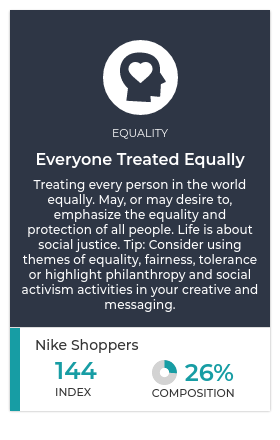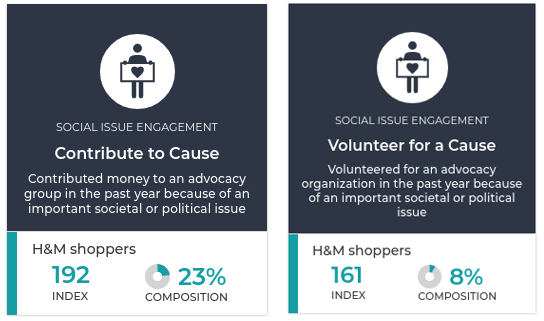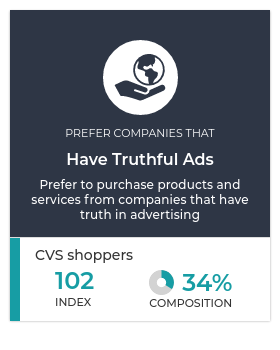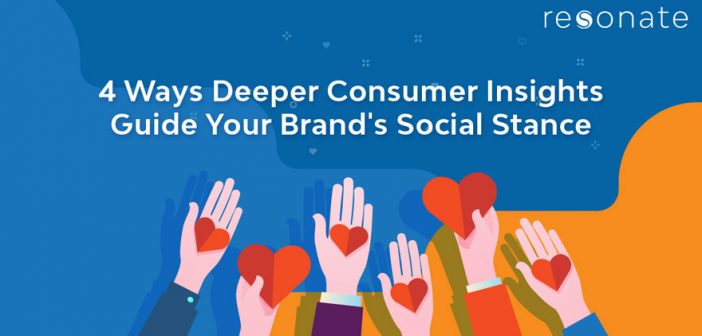4 Ways to Drive Performance with Corporate-Consumer Value Alignment
Companies were often hesitant to speak out on social issues, unless it was tax or regulation-related because they had nothing to gain and everything to lose. Their creative and messaging focused on the brand promise, product or service feature they were selling and that’s all consumers expected.
Today, people want more from brands. It’s not enough to just sell a product or service; consumers want to buy from companies that champion the values and causes that are important to them. In fact, nine in 10 consumers say that if a company promotes the values they care about, they will go out of their way to do business with them, pay a premium for their products or recommend it to friends and family*. Companies are now beginning to understand the value in aligning to the right causes and movements. Eight in 10 B2B and B2C companies in the U.S. that put their corporate values into action say they expect to see profit growth within the next five years*. The reality is, consumers are human, and they want their brands to be too.
So how does a brand take a stand on a cause or issue without irking prospects who don’t agree, setting off a frenzy of customer churn or eroding brand value? How do you show your customers that your brand really does care about an issue and it’s not part of a larger marketing ploy? In essence, how does your brand authentically take a stand that aligns to your brand values and reinforces your brand promise? Here are four ways to ensure you get it right and create meaningful, lasting relationships with your customers.
1. Support issues that align with your products and services
Avoid taking a stand on a cause just because it’s trending in the news or because it seems like every other company has something to say on the matter. Choose an issue that’s related to your core business proposition and makes sense based on your company’s products or services. Make sure the cause or issue represents your brand across your entire ecosystem. For example, if you’re taking a stand on gender equality, make sure your employee makeup reflects that. If not, it might be beneficial to focus on something else, or make a public pledge to address the gender equality issue within your own business.
One company that champions causes in line with its brand mission is Patagonia. In December 2017, President Trump issued an order reducing the size of nationally protected land in Utah by almost 2 million acres. Patagonia replaced their usual homepage with the phrase, “The President Stole Your Land” written in white, bold letters. This wasn’t part of a big marketing blitz or campaign strategy; it simply fit in well with their mission statement: “Use business to inspire and implement solutions to the environmental crisis.” It was an authentic way to take a stand on something the company has always been passionate about. This type of brand to value alignment builds brand equity. It also drives customer loyalty by authentically aligning to the values of their customers.
Another successful example of staying true to company values is Brandless, an e-commerce company that sells its own household and food products. Every time a customer makes a purchase, they donate a meal to the Feeding America network of food banks. This act of charity directly correlates to the company’s mission statement: “Brandless was brought to life with the intention of making better stuff accessible and affordable for more people.” They’re also dedicated to providing value to the greatest number of people possible, and they want to give back every day, according to their website. Their dedication to this cause fits in perfectly with the core of who they are as a business, so it doesn’t feel like a marketing tactic, it feels authentic to who they are.
2. Understand the values and psychological drivers of your customers
Creating a deep, emotional connection with your consumer requires an understanding of what that makes them human—their values and motivations. What motivates them to get out of bed every morning? What are they passionate about? Understanding their psychological drivers and values will guide your approach on championing a cause. For example, women who buy Nike products are 44% more likely to value equality. According to Resonate insights, these individuals emphasize the equality of all people and believe life is about social justice. Nike’s #DreamCrazy campaign successfully tapped into that belief with their most recent ad. Their creative and messaging highlighted some of the most decorated female athletes challenging the gender bias in sports. The reaction on social media was widely positive and the campaign deepened brand affinity, particularly with women.
Resonate Personal Values

Another successful example of a brand reflecting its customers values was Lyft’s reaction to Trump’s travel ban in January 2017. Its founders wrote an email to its users outlining its plan to donate $1 million to the ACLU over the next four years, citing that the travel ban was, “antithetical to both Lyft’s and our nation’s core values.” The letter also stated, “We created Lyft to be a model for the type of community we want our world to be: diverse, inclusive and safe.” This aligned with the core values of Lyft riders; 25% of them believe everyone in the world should be treated equally and that life is about social justice, according to Resonate insights.
3. Uncover how your customers engage in civic expression
Understanding the causes to champion that reflects both your brand and customer is just a piece of the puzzle; learning how to do that in a way that speaks to your customer in a meaningful way is just as important. Resonate reveals the different ways consumers show support for the causes that matter to them, and its critical you implement their preferred method of civic expression in order to strengthen your connection even further.
For example, H&M’s garment collecting initiative, incentivized customers to bring their old clothes to their local store so they could reuse and recycle them. Doing so would result in the donors receiving 15% off their purchase. According to Resonate’s insights, H&M customers are 92% more likely to contribute to a cause and 61% more likely to volunteer for a cause than the average U.S. shopper, meaning they value social engagement beyond monetary donations. H&M’s initiative correlates with their customer’s preferred avenue of civic expression, and it highlights their commitment to social responsibility.
Resonate Personal Values

Another prime example is Southwest Airlines. 31% of Southwest customers donate money to charity as their preferred method of giving back. The airline’s “Points for a Purpose” program gives its customers the opportunity to donate their frequent flyer points to nine different charities, including All Hands Volunteers, American Red Cross, Make-A-Wish and Ronald McDonald House Charities. The airline shows that it values its customers by giving them an outlet to express their social activism in a way that’s meaningful to them.
4. What motivates your customers to choose or abandon a brand?
Understanding what factors drive your customers to advocate or buy from one brand over another is crucial to keeping your customers loyal. Having insight as to why they buy what they do informs your brand about what you can do differently. This is particularly helpful when it comes to championing a cause. If insights reveal that your shoppers prefer companies that reduce packaging, consider getting involved with waste reduction on a bigger scale in order to reach your customers on an emotional and personal level.
For example, according to Resonate’s insights, 34% of CVS customers prefer doing business with companies that have truthful ads. CVS recently launched an initiative called “Beauty Unaltered” in which they plan to identify beauty advertisements found in their store that have been digitally altered. Explaining further in their official statement they said: “We believe we have an opportunity, and responsibility, to think about the messages we send to our customers and how they impact their health.”
Resonate Personal Values

Another company that taps into the motivations of its customers is Kohl’s Their shoppers are 33% more likely to do business with a company that reduces energy use, and the department store does just that. They joined the EPA Green Power Partnership over 10 years ago and started installing solar systems in their stores. They also continue to be one of the biggest consumers of green energy, as they largely use alternative energy sources to power their stores and corporate offices. Tapping into the very core of what drives their customers strengthens their customer relationships.
Conclusion
One-fifth of U.S. consumers put values first, even ahead of competing factors like price and convenience*. When brands take a stand on a cause or issue, they’re creating an emotional connection with their consumers by tapping into their values and motivation—and it’s working. People want their brands to be authentic, personable, trustworthy and above all else, human.
There are a few important steps to take to ensure the stand you’re taking isn’t perceived as a marketing ploy. Stick with an issue that aligns with your corporate values, don’t take a stand on something because it’s trending; understand your customers’ values, they should feel strongly about the issue you champion; discover how they engage in civic expression and attempt to mirror that; focus on what motivates your shopper to advocate for a brand. Following the above will help you avoid a blowback from your customers and instead deepen your connection and increase customer lifetime value.
–
This article first appeared in www.resonate.com
Seeking to build and grow your brand using the force of consumer insight, strategic foresight, creative disruption and technology prowess? Talk to us at +9714 3867728 or mail: info@groupisd.com or visit www.groupisd.com


